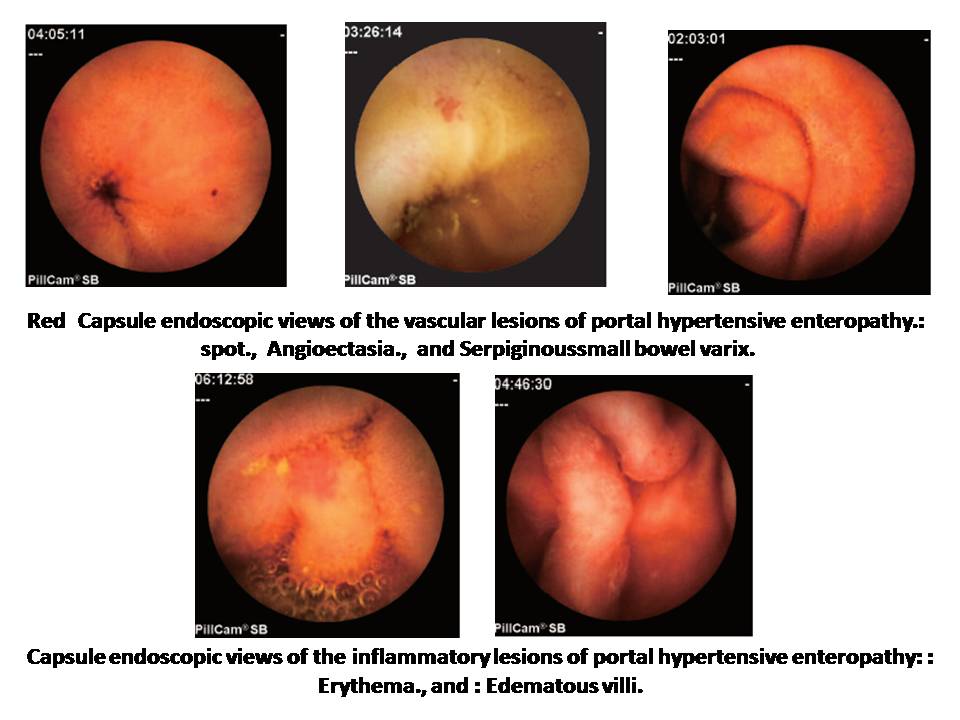Background and Aim: There is limited data about the frequency, and characteristics small-bowel lesions in cirrhotic patients with portal hypertension (PHT) detected by capsule endoscopy (CE) as well as, there is no scoring system to evaluate their severity. To date, there is no published study showed the association between portal hypertensive enteropathy (PHE) and transient elastography (TE). The objective of this study was to better define the mucosal abnormalities of PHE, and to determine whether these findings are associated with the severity of liver disease, esophageal varices, portal gastropathy, or other clinical characteristics. Moreover, we aimed to explore the clinical impact of TE in the field of PHE, and to create a reliable scoring system for mucosal findings of PHE detected by CE.Materials and Methods: We compared medical records of 31 cirrhotic patients complicated with portal hypertension (PTH) with 29 control patients who underwent CE. Our scoring system of PHE depends on classification of small bowel (SB) mucosal lesions into main four types; 1- red spots, 2- angioectasias, 3- SB varices, and 4- inflammatory like lesions. The first three types comprised the vascular lesions of PHE. Each of these four lesions worthy 2 points if it was multiple (more than 2 lesions), and only one point if it was not. We calculated the positive points for every patient to make a final PHE score of maximum 8 points.Results:
Mucosal lesions compatible with PHE were significantly more common in cirrhotic patients than control patients (67.7% vs. 6.9%, p < 0.001). The mucosal findings in cirrhotic patients included red spots (17 patients, 54.8%), angioectasias (16 patients, 51.6%), inflammatory like abnormalities (13 patients, 41.9%), and SB varices (5 patients, 16.1%). In control group, SB mucosal findings were present only in two patients and included red spots (one patient, 3.4%) and inflammatory-like abnormalities (one patient, 3.4%). Cirrhotic patients with low serum albumin level, high bilirubin level, low platelets count, worsening Child Pugh class, large EV, portal gastropathy, and history of endoscopic variceal injection sclerotheraphy or ligation (EIS/EVL) were significantly associated with PHE. On the other side, there is no difference between patients without PHE and those without PHE regarding hemoglobin concentrations and hemocrite values.Comparison between our proposed PHE score and clinical data of patients showed that patients with lower serum albumin level (p <0.02), higher serum bilirubin level (p = 0.005), higher TE score ( p= 0.004), higher Child-Pugh score (p = 0.011), larger EV ( p= 0.006), and prior EIS/EVL ( p = 0.006) were significantly associated with higher PHE score.Conclusions: Mucosal lesions compatible with PHE were significantly more common in cirrhotic patients than control patients (67.7% vs. 6.9%, p < 0.001). Cirrhotic patients with high TE score, worsenig Child-Pugh, large EV, and prior EIS/EVL are clinically associated with severe PHE. Transient elastography might be a new non-invasive tool that has a clinical impact for predicting presence and severity of PHE in cirrhotic patients especially if presented with occult gastrointestinal bleeding and the esophagogastroduodenoscopy and colonoscopy are negative


